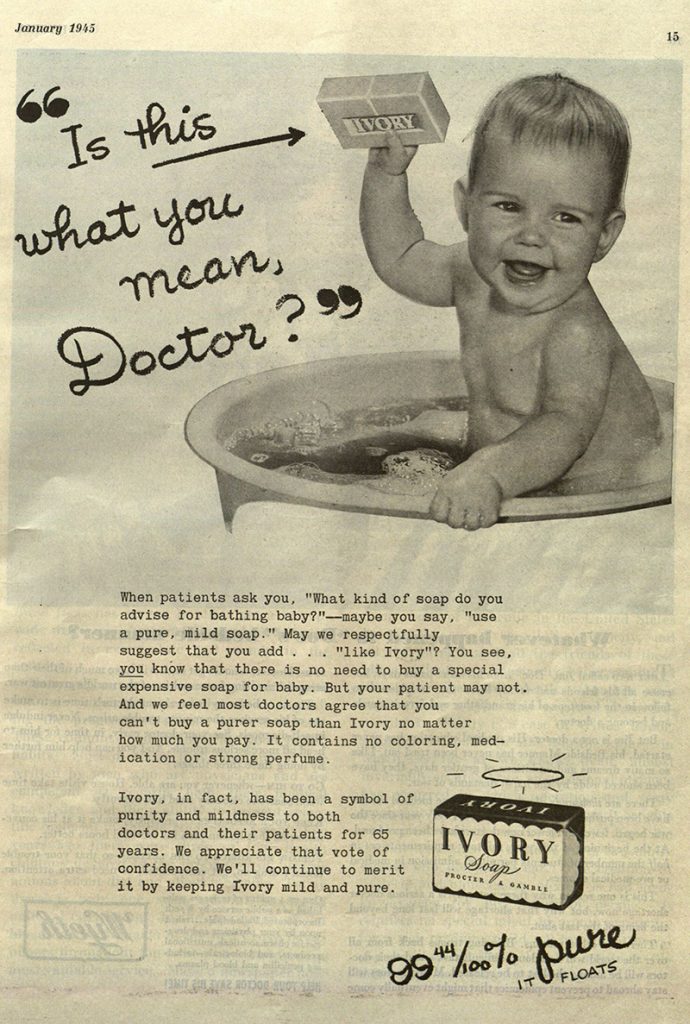When we set out to do historical research, we’re often very focused on the text – we want the book, the chapter, the journal article. But sometimes it’s just as important to pay attention to the paratext. Paratext is a word used to describe additional material supplied by authors, editors, printers, and publishers – for example, cover art, dedications, and advertisements.
 The advertisements here are from the journal Hygeia, a magazine published by the American Medical Association from 1923 until 1950 when it became Today’s Health. Unlike JAMA, their official journal for members, Hygeia was targeted at “the average intelligent layman – the man and woman on the street,” and the editors sought out pieces written in a way that was both informative and accessible to non-physicians. These included everything from long-form articles on stuttering, correct posture, and how to choose a physician; to personal essays, book reviews, and even cute poems meant to educate children about proper hygiene. Modern equivalents would be publications such as Men’s Health and Women’s Health.
The advertisements here are from the journal Hygeia, a magazine published by the American Medical Association from 1923 until 1950 when it became Today’s Health. Unlike JAMA, their official journal for members, Hygeia was targeted at “the average intelligent layman – the man and woman on the street,” and the editors sought out pieces written in a way that was both informative and accessible to non-physicians. These included everything from long-form articles on stuttering, correct posture, and how to choose a physician; to personal essays, book reviews, and even cute poems meant to educate children about proper hygiene. Modern equivalents would be publications such as Men’s Health and Women’s Health.
Hygeia also contained numerous advertisements. These can be just as informative as the articles themselves, although they require a certain amount of reading between the lines. For example, many of the ads in Hygeia feature beauty products, household cleaners and baby products. This immediately tells us that the publishers of Hygeia expected a portion of their readership to be women. If we look a little deeper, we can see what these advertisements tell us about contemporary ideas of femininity. Take a look at the advertisement for Nivea hand cream – a product you can still find on shelves today – from 1931. It features a woman posing sensually under the caption “Keep Hands That Wash Dishes Fit to Play Bridge.” The message here is obvious: although women are expected to keep their households clean, that doesn’t mean they should sacrifice beautiful hands.
Hygeia’s advertisements contain many other messages regarding female attractiveness. A 1945 deodorant ad shows a man and woman locked in an embrace, while the text below says ominously, “Are you as nice close up…as you are at a distance?” Remember to deodorize, ladies, or you might not find a beau! The shape of the body was just as important as its scent.
The two ads for maternity garments – one from 1934 and one from 1945 – reveal that pregnancy was no excuse not to have a perfectly sculpted waist (at least, not according to Lane Bryant). Both ads feature slender, perfectly coiffed women modeling girdles, an undergarment that has ceased to be a part of most women’s daily wardrobe (although Spanx and other shapewear brands have filled that gap), but sixty years ago, these were even part of maternity wear.
While digitization projects do an excellent job of capturing an item’s text, paratextual material like these advertisements is often at risk of getting lost. In some cases, advertisements only appeared at the end of the magazine, and they might be discarded altogether. In other cases, repositories might not hold scans of the actual pages, but only retain transcripts of the articles. For historians, this is an unfortunate loss. As these examples from Hygeia show, advertisements can tell us how attitudes toward our bodies change over time…and how they stay the same.





